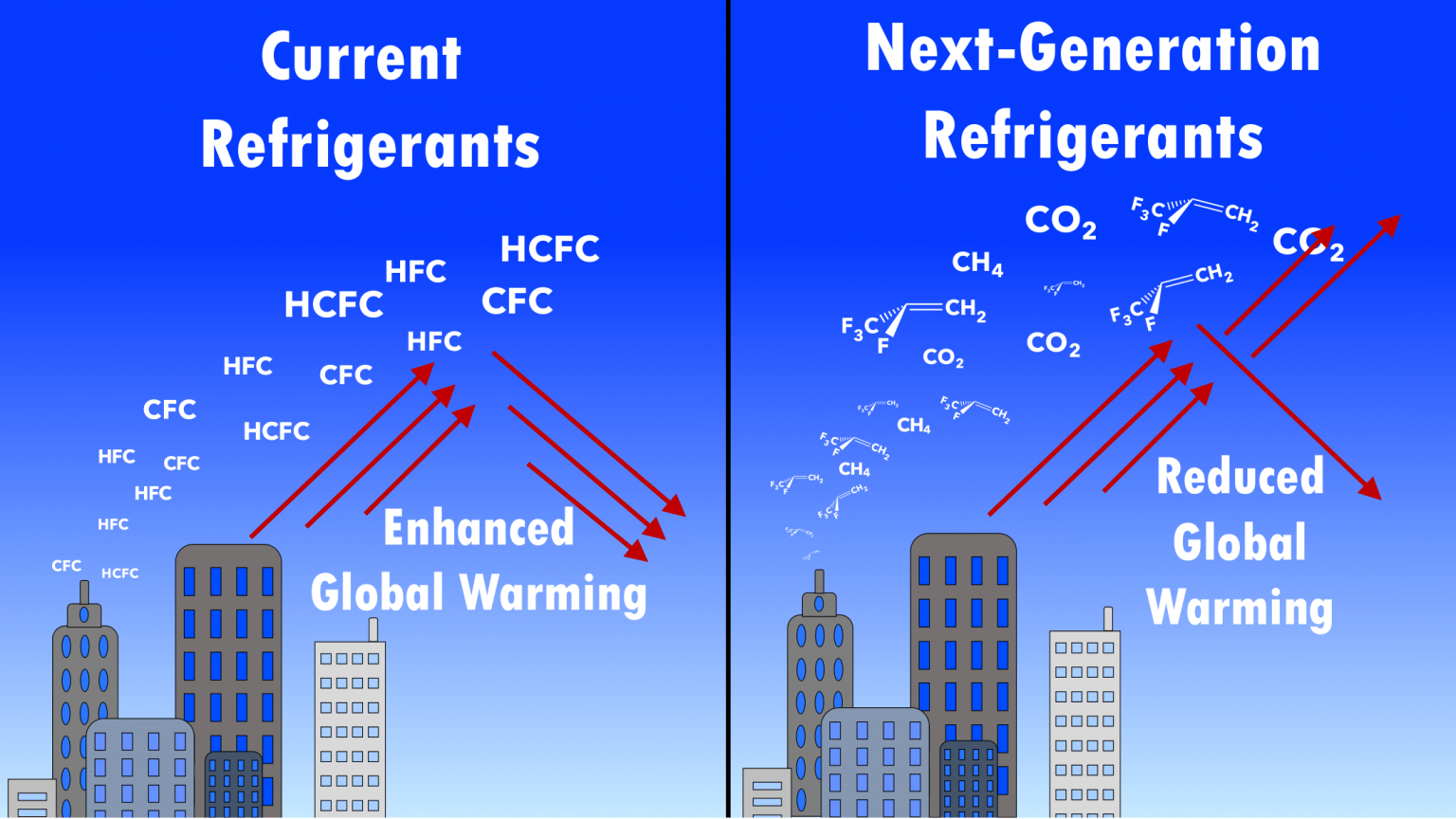Refrigerant Management
Refrigerant management involves controlling and reducing emissions of potent greenhouse gases used in cooling systems. Proper handling, recycling, and replacement of refrigerants can significantly mitigate climate change.

Regulating and reducing halocarbon refrigerant use to slow climate change (MIT Science Policy Review)
View open jobs in this Solution
Example Companies
- Daikin - Develops energy-efficient air conditioning systems and refrigerants.
- Honeywell - Produces low global warming potential refrigerants.
- Chemours - Manufactures sustainable refrigerant solutions.
- Tradewater - Collects and destroys potent greenhouse gases.
- A-Gas - Provides refrigerant recovery and reclamation services.
Overview
Refrigerant management is crucial for mitigating climate change, as many refrigerants are potent greenhouse gases. The Montreal Protocol has been successful in phasing out ozone-depleting substances, but challenges remain in managing newer refrigerants with high global warming potential.
Progress Made
Significant advancements have been made in refrigerant management:
- Montreal Protocol: Phased out production of ozone-depleting substances, reducing their global warming potential by 95%.
- GreenChill Program: EPA initiative helping grocery stores reduce refrigerant emissions.
- Low-GWP Refrigerants: Development of refrigerants with lower global warming potential.
The biggest benchmark from Speed & Scale
Commit and enforce the end of hydrofluorocarbons (HFCs)
Use their news tracking tool to track progress
Solutions by Sector
Commercial Refrigeration
- Natural Refrigerants: Using CO2, ammonia, or hydrocarbons as alternatives to HFCs.
- Leak Detection Systems: Implementing advanced technologies to quickly identify and repair leaks.
- Energy-Efficient Systems: Designing cooling systems that reduce overall energy consumption.
Case Studies:
- Whole Foods Market, USA: Implemented CO2 refrigeration systems in stores, reducing carbon footprint (EPA GreenChill).
- Carrefour, France: Adopted propane-based refrigeration systems in supermarkets (Carrefour).
- ALDI, Germany: Committed to using CO2 as a refrigerant in all new stores (ALDI).
Residential Cooling
- Heat Pumps: Promoting efficient heating and cooling systems with lower environmental impact.
- Smart Thermostats: Optimizing cooling usage to reduce energy consumption and refrigerant demand.
- Proper Disposal Programs: Ensuring safe collection and destruction of refrigerants from old appliances.
Case Studies:
- Daikin, Japan: Developed energy-efficient air conditioners using lower-GWP refrigerants (Daikin).
- Nest, USA: Created smart thermostats that optimize cooling and reduce energy use (Nest).
- Recycle My AC, USA: Program for proper disposal of old air conditioning units (Recycle My AC).
Industrial Refrigeration
- Ammonia Systems: Using ammonia as a zero-GWP refrigerant in large-scale cooling.
- Heat Recovery: Capturing waste heat from refrigeration systems for other uses.
- Cascade Systems: Combining different refrigerants to optimize efficiency and reduce environmental impact.
Case Studies:
- Lineage Logistics, USA: Implemented ammonia refrigeration systems in cold storage facilities (Lineage Logistics).
- Nestlé, Switzerland: Adopted natural refrigerants in industrial freezers and ice cream cabinets (Nestlé).
- Unilever, Netherlands: Committed to phasing out high-GWP refrigerants in ice cream freezers (Unilever).
Lessons Learned
- Life Cycle Management: Comprehensive understanding of refrigerant life cycle is crucial for effective management.
- Collection and Recycling: Efficient systems for collecting and recycling used refrigerants are necessary.
- Policy Support: Policies and regulations encouraging use of environmentally friendly refrigerants are important.
- Public Awareness: Raising awareness about the importance of refrigerant management is essential.
Challenges Ahead
- Awareness Gap: Lack of understanding about the impact of refrigerants on climate change.
- Financial Barriers: High costs associated with transitioning to new refrigerants and systems.
- Technical Expertise: Shortage of trained personnel for handling new refrigerant technologies.
- Global Coordination: Ensuring consistent implementation of refrigerant management practices worldwide.
Best Path Forward
- Education and Outreach: Increase awareness about the benefits of proper refrigerant management.
- Policy Implementation: Encourage governments and businesses to adopt stringent refrigerant management policies.
- Research and Development: Support ongoing R&D for low-GWP refrigerants and efficient cooling technologies.
- Infrastructure Investment: Develop infrastructure for proper handling, recycling, and disposal of refrigerants.
- Global Collaboration: Foster international cooperation to address refrigerant management on a global scale.
Image credit: MIT Science Policy Review